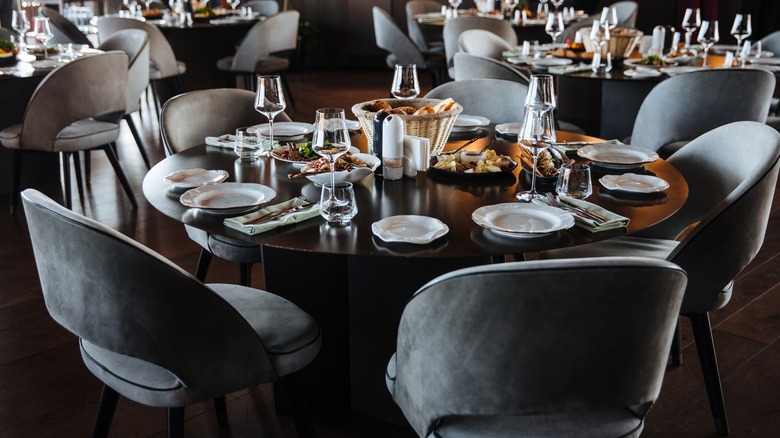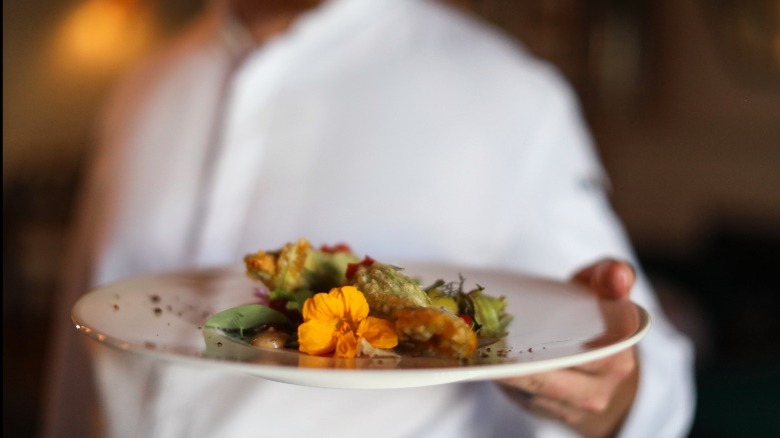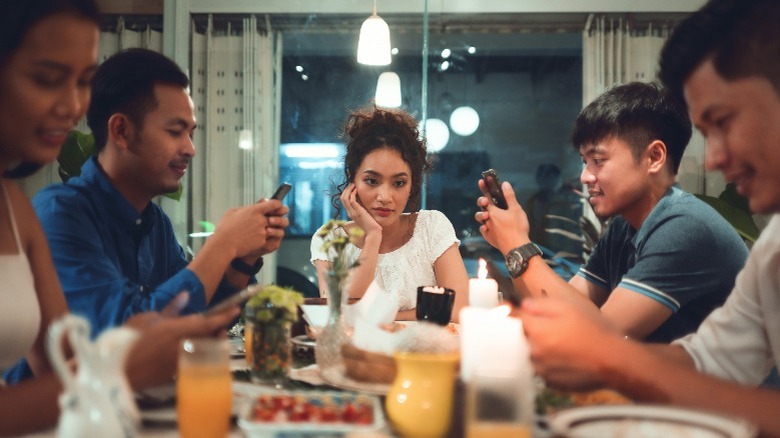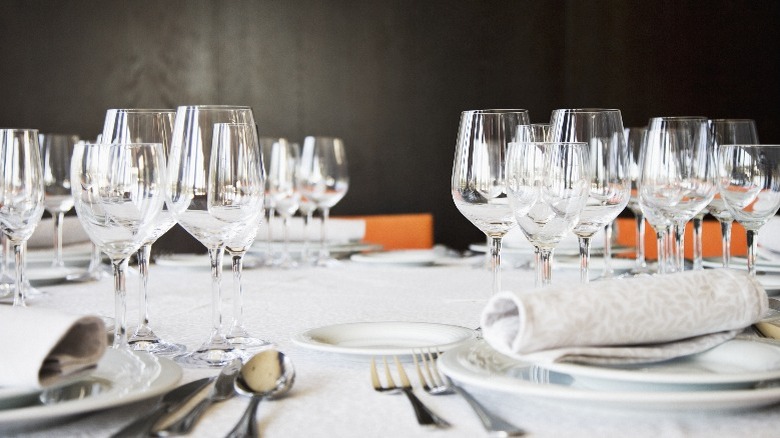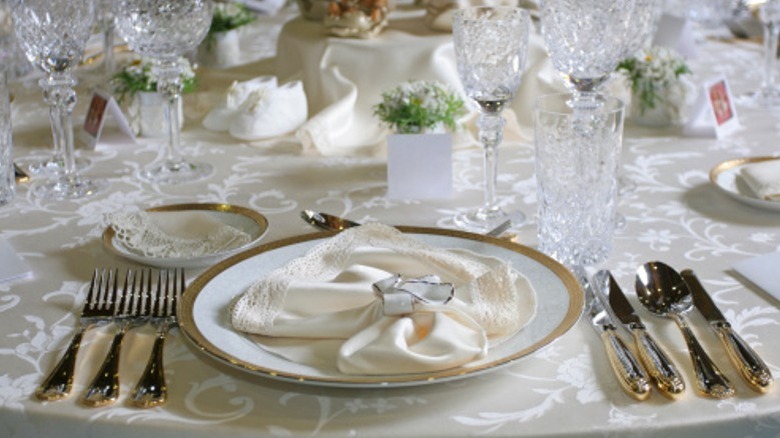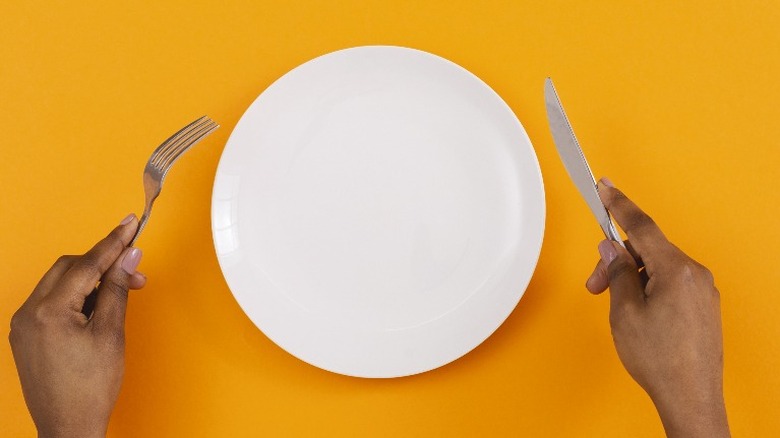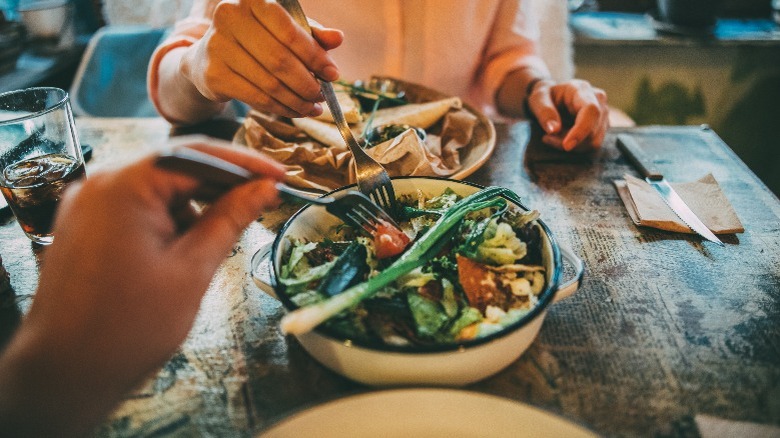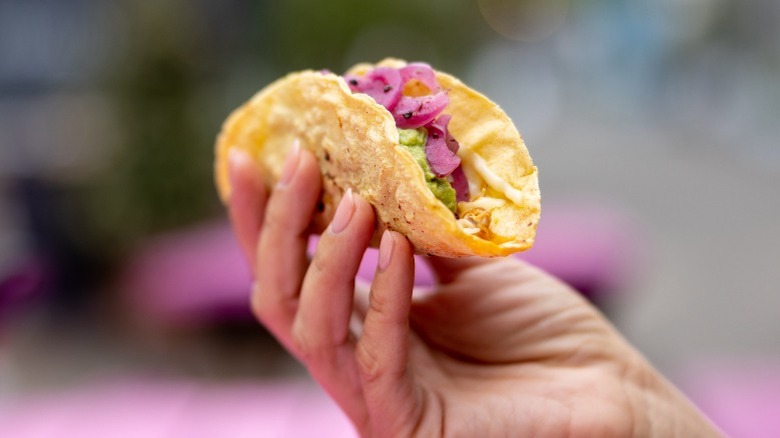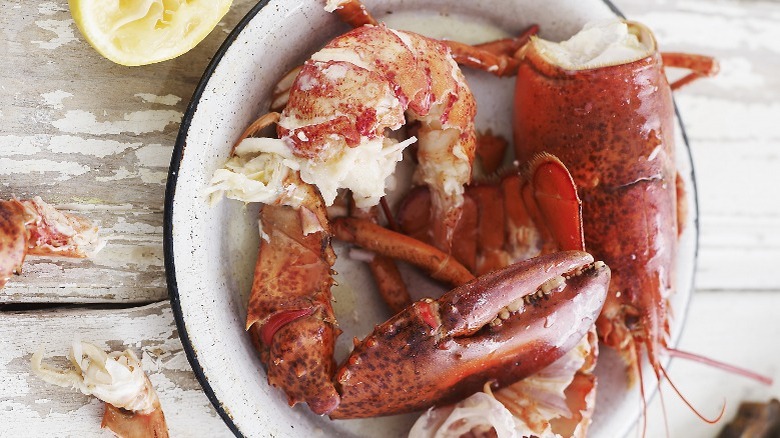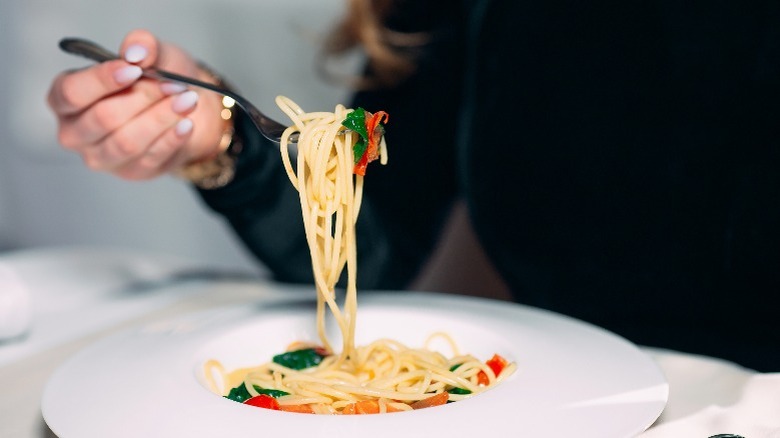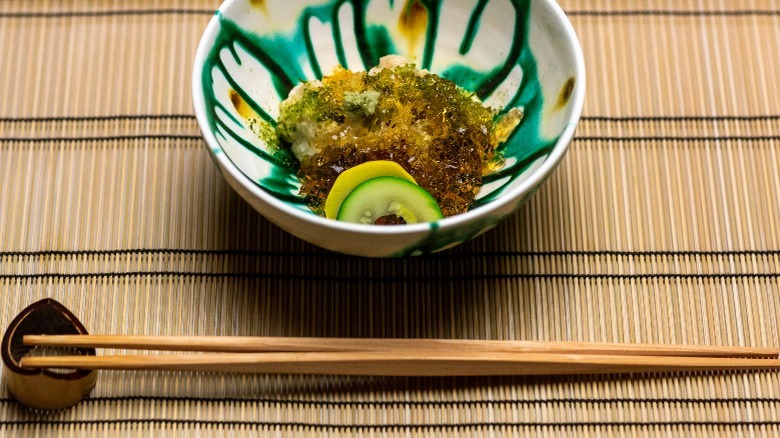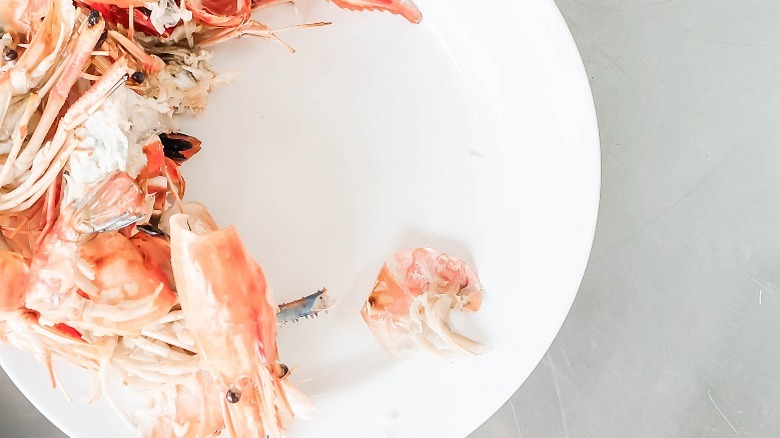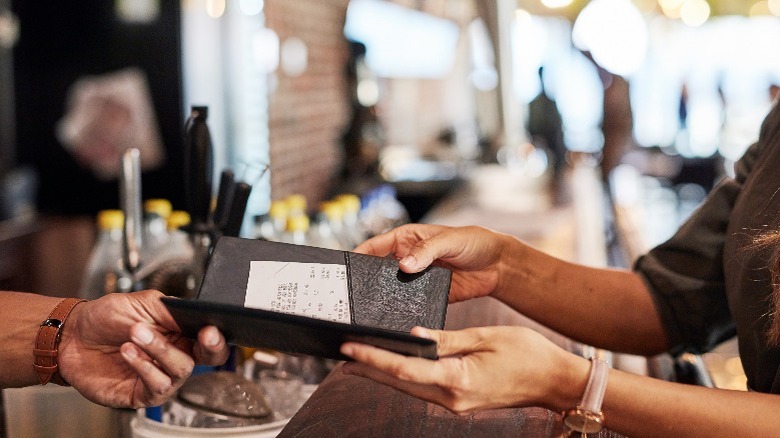15 Dining Etiquette Mistakes You Should Avoid
Whether you've been invited to a seven-course meal or you just have questions about how to eat soup in public, you might need some dining advice. And we're here for you. We have answers about what fork you need, how to dispose of olive pits, or when it's okay to eat with your fingers (asparagus sometimes, surprisingly). More often than not, most of our dining situations fall on the informal side of the spectrum but this doesn't mean we can forego basic etiquette rules. Manners aren't just about making you into a posh robot — good etiquette helps to make those around you feel respected and comfortable. And that's the key to getting invited back, darling — that and a divine hostess gift.
Unfortunately, if your first big occasion is eating lobster or oysters at a White House dinner, this guide is probably too little, too late. However, if you're just looking to get through a dinner with your (possibly) uptight in-laws then we have your back. So take off your hat, find your seat, and get ready to dig in.
1. Understand the difference between informal and formal dining rules
Knowing what type of event you'll be attending is half the battle — not just for brushing up on which fork goes where but also to give you an idea of what you might be expected to wear. If the invite or host isn't clear about what to expect, there are a few ways to suss out the context of the event. You can always ask the host, especially if they're someone close to you.
Next, take a look at the location. A birthday party in someone's backyard is bound to be more casual than one held at a Michelin-starred restaurant. Finally, while it's not recommended that you ask the host who else is invited (that can come across as a little tacky), if you received the invitation in an email or through social media, you might be able to see who else is going. That will give you a pretty good idea if it's mostly friends or colleagues, giving you an idea of what might be expected.
2. Don't ignore your dining companions for your phone
As we mentioned before, good dining etiquette isn't just about old-school rules like keeping your elbows off the table. When you're dining alone, feel free to scroll through your phone the entire time. However, when you're with other people, you might want to put that phone away. Obviously, there are exceptions to the rule — a new babysitter or a sick relative for example — but mindlessly thumbing through TikTok has never constituted an emergency.
Etiquette educator Candace Smith points out that formal dining rules stipulate that no object unrelated to the meal should ever be present at the table. Casual dining may not be as strict, but many people still frown on their use in the company of others. Whether or not it's rude to use your cell phone at the table continues to be widely debated ever since the arrival of these mini supercomputers. But consider this: Why would someone want to have dinner with a companion who obviously has better things to do?
3. Etiquette means being able to give (or receive) a toast
This one might not come up all that often, but bear with us ... it's better to be safe than sorry, right? Toasting someone doesn't need to be a prolonged affair unless you were asked prior to the event to make an actual speech. If you're simply toasting someone, you don't need to say much more than a few words about the occasion and the person. It doesn't even need to be more than a minute. Make eye contact with the person you're honoring, raise your glass to shoulder height, and make the toast.
If you're on the other side of the toast, you don't need to do much besides smile graciously and accept the compliment. If you're already seated, remain sitting during the toast even if the speaker is standing. At formal occasions, resist the urge to raise your own glass (this is fine to do in a smaller, casual setting) because it means that you're toasting yourself. After the toast, thank the host for the kind words and for the event.
4. It's alright to start eating if the host tells you to
There are occasions when you'll know that it's okay to begin eating before the host. Anytime you're snacking without being seated — say hors d'oeuvres and cocktails — you're fine to pop one in your mouth. An informal backyard barbeque is probably alright as well if people aren't all seated around one big table. Another situation where it's usually fine to start eating before everyone else is served is at a buffet. Obviously, in all these situations, use common sense to decide what to do. You don't want to be lining up for seconds before other diners haven't even received their first serving.
Being seated doesn't always mean that you need to wait, either. If the host tells you to go ahead, then you're free to start eating. If they haven't said anything, however, it might be best to wait. They may be planning a toast or blessing before the meal and having a mouthful of lasagna at that moment is a bad look.
5. Don't insult the chef by adding seasonings before tasting your food
While we acknowledge that everyone has different levels of what they like for flavor, we also know the effort we put into our cooking. Salt, pepper, hot sauce, or even our beloved Parmesan should be added after you take your first bite (or two). It seems presumptuous to think that the chef didn't do a proper job of seasoning the food they served you. And if they did, you're just going to ruin it by adding more salt or heat.
There's an easy way to tell if you should be adding seasoning to your meal at all. In a casual atmosphere, feel free to take a taste and then add whatever you like. In a formal dining situation, however, it can be offensive to salt your food at all. If you're in an upscale restaurant and you notice that there's no salt on the table, there's a reason for it. The chef has likely put hours of work into building each dish so that the flavors are perfectly balanced, and you shouldn't feel the need to tweak anything.
6. Figure out which plates and glasses are yours at dinner
This is a big one, we know. Unless you're seated at a table with loads of room and you can clearly see which bread plate is yours and which water glass you can sip, you might need a little hint. Plates and glasses can be especially confusing when seated at a round table, as there's no beginning or end to help you out.
With help from Emily Post, the doyenne of all things civilized, we have a foolproof way for you to pick the proper plate. If you were to make lowercase b and d with your hands, you'd notice that the bread plate just happens to be on your left-hand side and your drink is on your right-hand side. While this might just be a coincidence, it's also a terrific way to discretely ascertain where to drop your dinner roll (make your finger letters under the table if you have to). Another letter-based way to remember is to use the acronym "BMW" — bread, meal, water, from left to right.
7. Know when to use all the various forks and knives
Before we even get into the ways to hold your utensils, how do you even know which ones to use? In the most general terms, you'll be working your way in from the outside of the plate. This means that your salad fork will be on the outer left and the soup spoon will be on the outer right. Those are the basic American rules — for a continental-style dinner, you'll find the salad fork on the inside as that course is generally served after the main.
There's also a rule that there should never be more than three pieces of flatware on either side of the plate, so you should never be overwhelmed with a dozen utensils, fortunately. If more implements are needed, they will be served with the individual course. Depending on the dinner, your dessert spoon or fork may be placed above the plate or to the side. Finally, you can usually find your teaspoon on the right-hand side, beside your knife.
8. Be sure to hold your utensils properly
How you hold and use your utensils will depend on a few different things. In the U.S., many diners use the cut-and-switch method, using the left hand to cut food and then switching the fork to the left hand to eat. In the European or continental style, diners hold their knife in their right hand and use their left to eat, holding their forks with the tines facing down and picking up bites that way.
Now, this is all well and good if your left hand is your non-dominant hand. If you're a lefty, never fear. You'll still be able to manage, even in the most formal setting, with a little know-how and confidence. Many people find it easy enough to mirror either style, just in reverse, and there's nothing wrong with this way of dining. The biggest problem you'll face is a lack of elbow room, as you'll be overlapping with the person on that side. If you know the host well, request to sit at the end of the table so you can use your dominant hand freely and without impediment.
9. Don't monopolize a dish that was ordered to share
There are times when you just want to try everything on the menu, one bite at a time. And if your dining companions are down with it, you can get the best of all the options. But how do you split meals without making any major food-sharing faux pas? It can be trickier than it seems, especially if you're hungry and looking forward to just getting it in your belly.
To start, make sure that everyone is on board. If they're not, you might just have to suck it up and graciously order (and pay for) your own side of charbroiled oysters. The last thing you want is to ruin a friendship over splitting the bill for food no one wanted. And speaking of shellfish, part of that is taking into consideration dietary restrictions and preferences. Finally, once the crave-worthy dish has been delivered to your tableful of tasters, don't make the mistake of thinking that everyone wants as much dressing or lemon or salt as you might. Take an appropriate portion and pass it on, dressing and seasoning yours as you like.
10. Sometimes it isn't rude to eat with your fingers
Sometimes, it's perfectly acceptable to use your fingers to eat certain foods. Keep in mind that, like most other things on this list, you should take your cue from the host if you're in doubt. Another excellent clue that your fingers are welcome utensils is the presence of finger bowls on the table. Fried chicken, ribs, corn on the cob, sandwiches, and tacos are all perfectly fine to eat out of hand. In some instances, even asparagus or artichokes can be finger food because of some weird rules in fancy restaurants. If it's not drenched in sauce, feel free to put down your fork and use your digits — just don't lick your fingers afterward.
As for cocktail events, where you're mingling and snacking, eating with your fingers is practically the only way to go. It's unlikely that you'll be expected to use cutlery when you're not seated, so go ahead and grab a canapé as the tray makes its way by. However, keep in mind that these situations often occur in a meet-and-greet situation, so keep a napkin nearby to avoid introducing yourself with greasy paws.
11. Understand table manners for eating shellfish
All shellfish have their own set of etiquette and the best ways to eat them gracefully. Generally speaking, shellfish will be served with the appropriate cutlery needed like a seafood fork, nutcracker, or meat pick. Anything served in the shell will need to be cracked open, using either a nutcracker or your hands, before the meat can be removed with the appropriate fork. Move large pieces of meat to your plate and eat it from there. Oysters or mussels can be quietly sucked from the shell after being loosened with a fork, dipping them in any broth or sauce that they may be served with.
If served shrimp with tails, hold it by the tail and remove the meat with your fingers. All shells are discarded (you may be provided with a bowl for this purpose) and you should make liberal use of any finger bowl. Remember that repeated dipping of the same piece of food into cocktail sauce is only permissible if it isn't a shared bowl.
12. Know the proper etiquette for noodles and soup
In North America, there are a few rules to follow when dealing with noodles. Notably, no slurping, which isn't frowned upon in other parts of the world. If you're in a ramen or pho house, slurping up all the goodness is looked at with a certain amount of appreciation. But how to deal with long, saucy strands of pasta or a deep bowl of broth here, especially in a more formal setting?
You might think you know how to deal with noodles — either by cutting them all up into bite-sized bits or by wrapping them up using a spoon. The answer, sadly, is neither. Cutting your noodles up will only make you look like a child, to be honest. And you won't need the spoon if you only attempt a few noodles at a time and use the rise of the bowl to help twirl them. For soup, use the wide-bowl spoon and scoop towards yourself. Sip the liquid off the spoon, without slurping. To get the last of the soup, tilt the bowl away from you (to avoid spilling it into your lap) and spoon it up.
13. Not treating chopsticks with respect
Please forgive us for not going into chopstick etiquette at length; it's a very in-depth subject that crosses a number of countries and cultures. However, we can still offer you a few tips about general manners when it comes to using them. Remember that they're the favored utensil in many Asian countries and hold a deep significance. This means you should treat them with respect, so no poking your dining companions or scratching yourself with them.
To begin, it's considered very rude to rub your chopsticks together right after splitting them apart. This implies that your host is cheap and that you fear splinters from their utensils. Next, never leave your chopsticks standing upright in a bowl of food. In most Asian cultures, this is reminiscent of the incense left as an offering for the dead and is thought of very poorly. Always hold them together, without waving them around or using them to point at anyone. Finally, only use them on your own food. Like serving yourself with the fork you've eaten with, double-dipping your chopsticks is extremely rude. Often, there will be communal chopsticks that will stay with the dish, just for serving.
14. Dealing with the inedible parts of your meal
So you've dealt with what fork is used for what and where to put your bread roll. What about anything that you don't particularly want to finish off, like shrimp shells, woody asparagus ends, olive pits, lemon rinds, or who knows what else? And don't forget about gristle, the bane of a meat eater's existence.
First, how do you deal with something inedible in your mouth? It all depends on whether you were expecting it or not. If it's part of the meal, like an artichoke leaf or an edamame pod, just consume the edible part and carry on with your meal. If it's something unexpected, like that aforementioned gristle, just discretely remove it from your mouth and place it on your plate. You'll be thrilled to know that the upper left portion of your plate is the designated spot for anything inedible. Depending on the situation, you may also find that you've been provided with a separate receptacle for discards, especially when eating seafood.
15. Graciously accept when someone offers to split or pay the bill
In business situations, it's generally accepted that whoever invites (or hosts), is usually the person who foots the bill. If your boss invites you out and chooses the restaurant, it's (hopefully) their expectation to pay, too. For more casual dining, even if a friend calls you up and suggests the pub, you might still be expected to pay your share. For a birthday party, you might all be expected to chip in to pay for part of the celebrant's bill.
No matter how the evening plays out, it's best to be prepared to split the bill without question. At the very least, you should be able to pay for what you ate — disappointing, we know, but adult life is full of gristle, love. If your dining companion told you that they were treating you from the beginning, it's fair to assume that you shouldn't have to pony up. If you've offered to pay but your guest seems intent on helping out, you can refuse once, but if they continue to insist, then feel free to split the tab.
